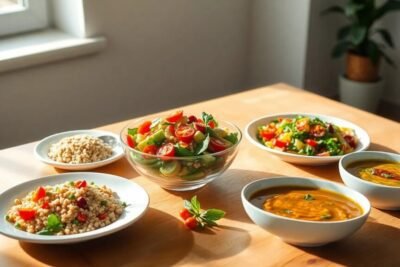
10 Diabetic Friendly Recipes for Effective Weight Loss
- Understanding Diabetes and Weight Management
- The Benefits of a Diabetic-Friendly Diet
- Grocery List Essentials for Diabetic-Friendly Cooking
- Breakfast Recipes for Energy and Satiety
- Lunch and Dinner Options for Flavorful Weight Loss
- Healthy Snacks to Curb Cravings
- Indulgent Desserts that Won't Spike Your Blood Sugar
- Meal Planning Tips for Busy Diabetics
- Understanding Portion Control and Balanced Meal Composition
- Conclusion and Encouragement for Your Health Journey
Understanding Diabetes and Weight Management
Diabetes is a chronic condition that affects how the body processes blood sugar, or glucose. There are two main types of diabetes: Type 1, where the body does not produce insulin, and Type 2, which is more common and often linked to obesity and sedentary lifestyle. Managing one's weight is critically important for individuals with diabetes, as excess weight can adversely affect blood sugar levels and overall health. When body weight increases, it can lead to insulin resistance, making it more difficult for cells to absorb glucose from the bloodstream. As a result, this can cause elevated blood sugar levels which further complicates diabetes management.
Weight management is essential not only in controlling diabetes but also in preventing the complications associated with the disease. Studies have shown that weight loss can significantly improve blood sugar control and reduce the need for medication in individuals with Type 2 diabetes. Therefore, incorporating diabetic friendly recipes for weight loss into daily meals can be a strategic approach toward achieving health goals. These recipes typically emphasize whole foods, lean proteins, healthy fats, and fiber-rich carbohydrates, which can help stabilize blood sugar levels while promoting weight loss.
The importance of a balanced diet in managing diabetes effectively cannot be overstated. A well-structured meal plan that includes diabetic friendly recipes for weight loss helps maintain satiety and provides essential nutrients while minimizing spikes in blood glucose. Foods rich in fiber, such as vegetables, whole grains, and legumes, can aid in digestion and promote a feeling of fullness, thus supporting sustainable weight loss. Additionally, maintaining a diet low in processed sugars and refined carbohydrates will contribute to improved insulin sensitivity. Understanding the relationship between weight management and diabetes ultimately empowers individuals to take control of their health more effectively.
The Benefits of a Diabetic-Friendly Diet
A diabetic-friendly diet plays a crucial role in managing diabetes effectively and promoting overall health. This dietary approach emphasizes the consumption of foods that help to improve glycemic control, allowing individuals to manage their blood sugar levels more effectively. By focusing on nutrient-dense foods, this diet can also support weight loss, which is essential for many individuals living with diabetes. The integration of various food groups tailored for those with diabetes can lead to significant health benefits.
One of the core principles of a diabetic-friendly diet is the inclusion of high-fiber foods. Fiber is essential for slowing down digestion, which can help maintain steady blood sugar levels. Foods rich in fiber, such as whole grains, legumes, vegetables, and fruits, not only provide satiety, reducing overall calorie intake but also contribute to heart health, a critical consideration for individuals with diabetes.
Furthermore, lean proteins, such as chicken, fish, beans, and legumes, are essential components of a diabetic-friendly meal plan. These proteins aid in muscle maintenance and help in weight management by promoting a feeling of fullness. Incorporating healthy fats from sources like avocados, nuts, and olive oil can improve overall cardiovascular health without causing significant spikes in blood glucose levels.
Additionally, focusing on low-GI (glycemic index) foods allows for more controlled blood sugar responses. Low-GI foods release glucose slowly into the bloodstream, which can prevent the insulin spikes associated with high-GI foods. This balance encourages not only better glycemic control but also a more sustainable approach to weight loss.
In conclusion, adhering to the principles of a diabetic-friendly diet can enhance overall health, facilitate weight loss, and improve glycemic control. By prioritizing fiber, lean proteins, healthy fats, and low-GI foods, individuals can craft meals that are both nutritious and delicious, paving the way for a healthier lifestyle.
Grocery List Essentials for Diabetic-Friendly Cooking
When managing diabetes and aiming for weight loss, assembling a well-structured grocery list is crucial. It should focus on a variety of fresh, whole foods that not only promote healthy eating habits but also support diabetic-friendly recipes for weight loss. A diverse selection of ingredients can ensure that meals are both nutritious and satisfying, minimizing cravings and promoting overall wellness.
Start with the vegetable section, which should be rich in leafy greens such as spinach, kale, and Swiss chard. Cruciferous vegetables like broccoli and cauliflower are also great choices, as they are low in carbohydrates and high in fiber. Including a colorful variety of vegetables, such as bell peppers, carrots, and zucchini, enhances nutritional intake while providing essential vitamins and minerals.
Next, venture into the whole grains aisle. Opt for quinoa, brown rice, and whole grain bread that provide fiber and complex carbohydrates. Avoid processed grains that can spike blood sugar levels. Legumes such as lentils, chickpeas, and various beans are excellent sources of plant-based protein and fiber, making them ideal for creating diabetic-friendly recipes for weight loss.
For protein selection, choose lean options like chicken breast, turkey, and fish, particularly fatty fish such as salmon and mackerel, rich in omega-3 fatty acids. Tofu and tempeh offer great plant-based protein sources, providing versatility in meals. Healthy fats should not be overlooked, incorporating items like avocados, nuts, and olive oil, which can help keep you satiated and support heart health.
By focusing your grocery list on these essential food groups, you will be well-equipped to construct wholesome and flavorful meals that align with your dietary goals. Overall, emphasize the importance of fresh, whole foods and minimize processed options for the best results in managing diabetes and achieving weight loss successfully.
Breakfast Recipes for Energy and Satiety
Breakfast is often considered the most important meal of the day, particularly for individuals managing diabetes. Starting the day with diabetic friendly recipes for weight loss can significantly impact energy levels, satiety, and overall well-being. Here are some wholesome breakfast ideas that not only taste delicious but also stabilize blood sugar levels while promoting weight loss.
One excellent option is a classic overnight oats recipe. By combining rolled oats with unsweetened almond milk, chia seeds, and a pinch of cinnamon, you can create a nutritious breakfast that is low in sugar and high in fiber. To enhance flavor and nutrients, consider adding fresh berries or sliced almonds as toppings. This dish provides complex carbohydrates that support prolonged fullness, making it a suitable choice for weight management.
Another delightful breakfast suggestion is an egg and vegetable scramble. Whisk together eggs, which are a good source of protein, and then sauté fresh spinach, bell peppers, and onions in a non-stick pan. The high fiber content from the vegetables provides bulk to your meal, aiding digestion and promoting satisfaction. Pair this dish with a slice of whole-grain toast for added fiber and sustained energy release throughout the morning.
For those who prefer smoothies, consider blending Greek yogurt with a handful of leafy greens, half a banana, and a tablespoon of nut butter. This combination creates a creamy and satisfying drink that is not only low in sugars but also packed with probiotics and healthy fats. The addition of flaxseeds or chia seeds can further enhance the nutritional profile, making it a perfect diabetic friendly option for breakfast.
Integrating these diabetic friendly recipes for weight loss into your morning routine can facilitate weight control while ensuring you start each day energized and satisfied. Each of these recipes emphasizes nutrient-dense ingredients, making them ideal for individuals seeking to maintain balanced blood sugar levels and support their health goals.
Lunch and Dinner Options for Flavorful Weight Loss
When it comes to adhering to a weight loss plan that is suitable for individuals with diabetes, thoughtfully crafted lunch and dinner recipes can provide both delicious flavors and healthy nutrients. The focus should be on incorporating lean proteins, non-starchy vegetables, and healthy fats to create satisfying meals that promote optimal blood sugar levels. This section will outline various diabetic friendly recipes for weight loss, ensuring a delightful culinary experience.
One excellent option for lunch is a grilled chicken salad. Utilizing skinless chicken breasts as a protein source, paired with a variety of vibrant vegetables such as bell peppers, cucumbers, and leafy greens, this dish is packed with nutrients while remaining low in calories. Drizzling with a light vinaigrette made from olive oil and vinegar adds healthy fats that contribute to overall well-being. This combination not only enhances the flavors but also supports weight management.
For dinner, consider a quinoa and black bean stir-fry. Quinoa serves as a superb grain alternative, rich in protein and fiber, while black beans add additional protein and a hearty texture. Complement the dish with a mix of sautéed non-starchy vegetables such as zucchini, spinach, and broccoli. Seasoning with herbs and spices enhances the flavors without adding excess sodium or sugar. This balanced meal exemplifies a diabetic friendly recipe for weight loss, offering a wholesome profile that keeps you full and satisfied.
Meal prepping can greatly aid in achieving these goals; dedicating time to prepare lunches and dinners in advance allows for better portion control and adherence to nutritional guidelines. By creating a plan that features a mix of lean proteins, vegetables, and healthy fats, individuals can maintain a delicious and nutritious meal routine while effectively managing their weight. The options listed are just the beginning of the myriad of flavorful and fulfilling meals available to support weight loss journeys while empowering those with diabetes.
Healthy Snacks to Curb Cravings
For individuals living with diabetes, managing cravings between meals can be a significant challenge, particularly when trying to adhere to a weight loss plan. It is essential to have a selection of diabetic-friendly recipes for weight loss that are not only low in sugar but also high in nutritional value. These snacks can help maintain energy levels, curb hunger, and support overall wellness while allowing for mindful eating practices.
One excellent option for a healthy snack is a mix of raw nuts, which provide a rich source of protein and healthy fats. Almonds, walnuts, and pistachios are particularly beneficial, as they can help stabilize blood sugar levels and provide lasting satiety. A small handful can easily be measured out to ensure portion control, making it a convenient choice for on-the-go consumption.
Fresh fruits and vegetables also make for fantastic snacks. Consider pairing a small apple or pear with a tablespoon of almond butter for a satisfying combination of fiber and healthy fat. Alternatively, raw veggies such as carrots, cucumber, or bell peppers can be enjoyed with hummus, offering a nutritious option that promotes both crunch and flavor. These snacks are not only diabetic-friendly but also support weight loss by being low in calories while delivering essential nutrients.
Another creative snack option includes Greek yogurt mixed with seeds and a sprinkle of cinnamon, which enhances flavor without added sugar. The protein content in Greek yogurt can aid in feeling fuller for longer, reducing the likelihood of overeating during main meals. Lastly, portioning your snacks into small containers can help maintain mindful eating habits, making it easier to manage cravings without excessive calorie intake.
In summary, incorporating these healthy snacks into your daily routine can provide effective support for weight loss while catering to the dietary needs of individuals with diabetes. Focus on variety and balance, and remember that mindful eating practices play a critical role in achieving your health goals.
Indulgent Desserts that Won't Spike Your Blood Sugar
Creating indulgent desserts that cater to diabetic needs can be a delightful venture. These recipes are not only satisfying but also formulated to maintain stable blood sugar levels. Utilizing alternative sweeteners and healthy fats, you can whip up treats that deliver on flavor while supporting weight loss goals. One popular choice is using natural sweeteners like stevia or erythritol, which do not significantly impact blood glucose levels, making them a perfect addition to your diabetic friendly recipes for weight loss.
Consider crafting a rich chocolate avocado mousse. By blending ripe avocados with unsweetened cocoa powder, a touch of stevia, and a dash of vanilla extract, you create a creamy, decadent dessert that is both nutritious and low in sugar. The healthy fats found in avocados help to promote satiety while offering a velvety texture that satisfies chocolate cravings without the blood sugar spikes associated with traditional mousse recipes.
Another delightful option is chia seed pudding. This versatile dessert can be prepared with almond milk or coconut milk and sweetened with your preferred low-calorie sweetener. The chia seeds not only add a satisfying texture but are also rich in fiber, which aids in digestion and promotes a feeling of fullness. By infusing the pudding with flavors such as vanilla, cinnamon, or even cocoa, you can tailor it to your taste preferences while ensuring it remains blood sugar-friendly.
Fruit-based desserts also offer a way to enjoy sweetness without compromising health. Baked apples topped with cinnamon and a sprinkle of chopped nuts create a warm and comforting treat. The natural sugars in the apples are balanced by the fiber content, and the nuts provide healthy fats that further stabilize blood sugar levels. These indulgent yet manageable dessert options underscore that healthy eating can indeed include enjoyable sweets, without guilt or health risks.
Meal Planning Tips for Busy Diabetics
For individuals managing diabetes, effective meal planning is crucial in maintaining stable blood sugar levels while also promoting weight loss. Proper planning can alleviate the stress of daily cooking and encourage consistent adherence to diabetic-friendly recipes for weight loss. Here, we outline several practical strategies to simplify the meal planning process for those with busy lifestyles.
Firstly, batch cooking is one of the most efficient practices to adopt. Set aside a couple of hours each week to prepare large quantities of meals that adhere to your dietary needs. This could involve cooking whole grains, lean proteins, and an array of non-starchy vegetables. By storing these components separately in your refrigerator, you can quickly assemble a variety of diabetic-friendly meals throughout the week, minimizing the temptation to opt for fast food or processed options.
Another effective strategy is to incorporate leftovers creatively into your meal plans. For instance, if you prepare a grilled chicken breast one evening, consider using it the following day in a salad or whole grain wrap. This not only reduces food waste but also allows you to enjoy diverse flavors without significant additional effort.
When creating balanced meal plans, it is essential to consider portion sizes and macronutrient distributions that align with your goals. Incorporate a protein source, healthy fats, and non-starchy vegetables in each meal, which can support both blood sugar control and weight loss. Additionally, utilizing a calorie-tracking app can help maintain awareness of your food intake and make necessary adjustments to fit into a weight loss plan.
Finally, customizing your meal planning process to fit your own preferences and schedule is vital. Make sure to incorporate recipes that you genuinely enjoy, as this will enhance the likelihood of sticking with your meal plan long term. By implementing these strategies, busy diabetics can effectively navigate the challenges of meal preparation while enjoying convenient and satisfying diabetic-friendly recipes for weight loss.
Understanding Portion Control and Balanced Meal Composition
Portion control is a critical aspect of managing one's diet, particularly for individuals following diabetic friendly recipes for weight loss. It refers to the practice of being conscious of the amount of food consumed during meals and how it fits into an overall nutritional framework. The importance of portion control lies in its potential to help regulate blood sugar levels while promoting healthier eating habits. By understanding how to properly measure and serve food, individuals can enjoy a variety of foods without overindulging.
When composing balanced meals, one should aim for a mix of macronutrients, including carbohydrates, proteins, and fats. A recommended approach is to divide your plate into sections, with half reserved for vegetables, one-quarter for lean proteins, and one-quarter for whole grains or legumes. This visual guide not only assists with portion control but also helps in selecting foods that provide essential nutrients. For instance, non-starchy vegetables such as broccoli or leafy greens can greatly enhance the nutrient density of meals and are very low in calories, making them ideal for weight loss while maintaining stable blood sugar levels.
Additionally, incorporating healthy fats in moderation, such as avocados or olive oil, contributes to satiety and overall well-being. When creating diabetic friendly recipes for weight loss, each ingredient should be thoughtfully chosen to ensure that it aligns with dietary needs while also considering portion size. For example, a simple stir-fry can be made using a variety of colorful vegetables, a source of lean protein like chicken or tofu, and a small portion of brown rice. By adhering to proper portion sizes and balancing meal composition, individuals can cultivate healthier eating patterns that help manage diabetes effectively and support weight loss goals.
Conclusion and Encouragement for Your Health Journey
Embarking on a health journey, especially while managing diabetes, can often seem daunting. However, it is essential to recognize that success is achievable with the right combination of knowledge, support, and determination. The diabetic friendly recipes for weight loss discussed in this blog post not only highlight delicious and nutritious options but also serve as a reminder that food can be both enjoyable and health-conscious. Each recipe equips you with a tool to help maintain proper blood sugar levels while contributing to weight loss.
Transitioning to diabetic friendly meals may require some adjustments, but these changes can lead to long-term benefits. Embracing a variety of ingredients encourages diversity in nutrition, which is key for maintaining overall health. Furthermore, meal planning around these recipes can simplify daily choices, helping you to stay on track and make healthier decisions effortlessly. Focusing on portion control and balanced meals is essential for anyone looking to lose weight while effectively managing their diabetes.
Let this be an encouragement that you are not alone on this journey. Many have successfully navigated the path of weight loss while managing diabetes, and with the increasing accessibility of resources, creating meals that cater to your dietary needs has never been easier. Remember to engage with supportive communities, seek professional guidance when necessary, and celebrate your progress, no matter how small. Each step you take brings you closer to your health goals. By incorporating diabetic friendly recipes into your routine, you are taking a proactive approach towards a healthier lifestyle, proving that weight loss and diabetes management can indeed go hand in hand.










